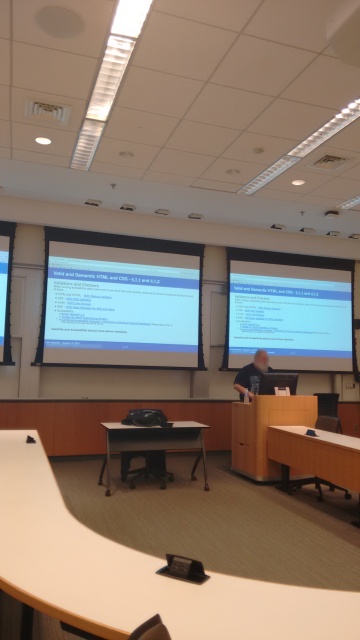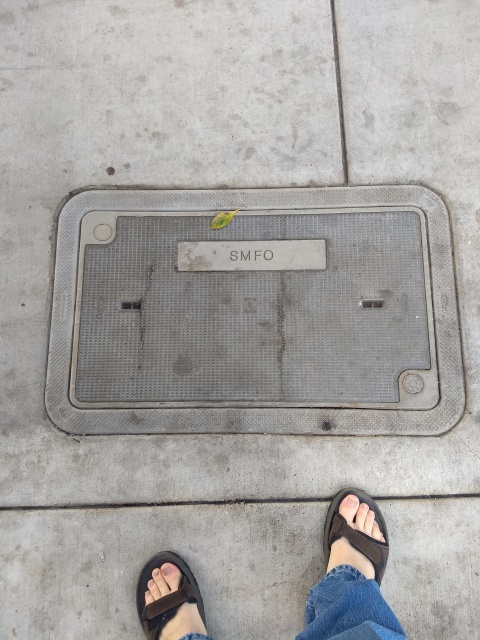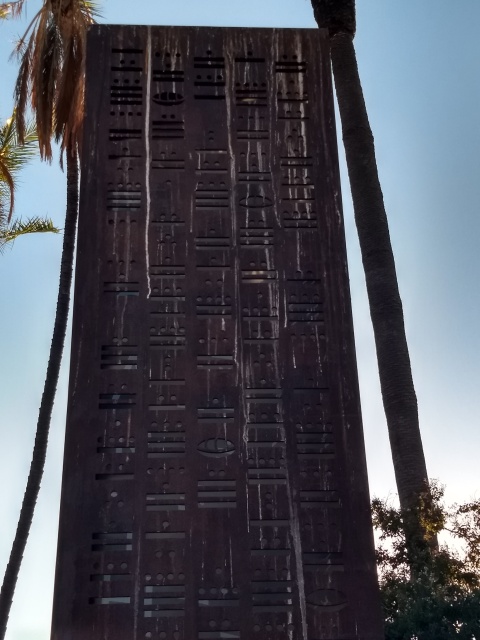Mark Dominus (陶敏修)
mjd@plover.com
I have another blog that doesn't suck.
Archive:
| 2023 | JF |
| 2022: | JFMAMJ |
| JASOND | |
| 2021: | JFM |
| 2020: | JFMAMJ |
| JASOND | |
| 2019: | JFMAMJ |
| JASOND | |
| 2018: | JFMAMJ |
| JASOND | |
| 2017: | ND |
Comments disabled
Last night's post counting up the last initials of people in the U.S. hit a roadblock just before publication. It included this chart:
But it almost contained this one instead:
I realized at the last moment that this chart was wrong. It claims
that ‘A’ is far and away the most common initial. This is because the
last item in the Census Bureau's data file is 29 million people with
ALL OTHER NAMES and I counted it with the A's. I had to redo the
data analysis, rebuild the chart, and rewrite part of the article.
Julia Evans says
this is such a perfect description of data analysis
I nerdsniped myself with observation this morning that there is no U.S. president whose (last) name began with ‘S’.
I bring you this more detailed investigation. The red bars are data taken from the 2010 U.S. Census, and include all names that occurred at least 100 times; that's the 162253 most common names.
For example, about 9.5% of U.S. people counted in 2010 had names beginning with ‘S’. If U.S. presidents matched this rate, we would expect around 4.3 presidents to have had ‘S’ names. Instead, there are none.
In contrast, there are 4 presidents whose names began with ‘J’. (Jefferson, Jackson, and two Johnsons.) Only about 8–9 million Americans have names beginning with ‘J’. If ‘J’ names occurred at the higher presidential rate we would expect more like 26 million.
The correlation of the two variables is 55%.
The raw data is here, and some additional data is available.
Incidentally, there has never been a major-league baseball player whose name began with ‘X’. Dean Xingu was a pseudonym for his real name, Dean Zorn.
No President of the United States has had a surname that began with the letter ‘S’.

Facebook users are asked to guess the correct amount of teeth in a jar and tag a friend in the comment section under the photo of the teeth. … The winner will be announced Friday and will receive $100 in Downtown Dollars to be used at participating merchants.
(Usher, Amanda M. "Mysterious teeth featured in giveaway", Valdosta Daily Times, 29 October 2018.)
When I first saw this I misunderstood the headline. I thought the teeth themselves were the prize for guessing closest, as is often the case with jars of jelly beans. I am so disappointed!
Looking for something else, I found this article that I posted on Usenet in 2001. I am repatriating it here. It concerns a particular feature of David Brin's Sundiver universe:
The galactic society doesn't accept the concept of "real number", only finite rational approximations.
I've spent a lot of time thinking about exactly this problem, whether the real numbers might be a sufficiently artificial construction that the aliens, when they come, won't have them. The conclusion that I've always come to is that the real numbers are unavoidable.
The aliens will be unable to avoid the Pythagorean theorem, noting, for example, that the diagonal of a 3×4 rectangle has length exactly 5. The Egyptians knew this three thousand years ago, and the aliens cannot possibly miss out on it and still be able to construct space ships. Of course, they call it the Blorkskug theorem, after the famous Nogulobular Blorksug Urbulgolp. But that's ancient history.
The aliens will then observe that if the Blorkskug theorem is to hold, then the diagonal of a square, whose edge is exactly one florzbeem, must have length of !!d!! florzbeems, where !!d·d = 2!!.
The alien mathematicians might refuse to admit that the diagonal has any well-defined length, but that's a rather obtuse philosophical position. (No pun intended.) It's quite concrete and specific. Mathematicians get paid to solve engineering problems, not to sit in pubs and insist that you're an idiot for wanting to measure the distance between the west and east corners of your wet glotzpurg field. If an alien mathematician loftily informed you that you can't measure that because there is no such number, you'd hit him in the dewlaps. (Ouch!)
Now the aliens take out a florzbeemstick and measure the diagonal of the wet glotzpurg field and find that it seems to be about !!\frac75!! florzbeems. Well, it must be a little more, because the !!\frac75· \frac75 = \frac{49}{25}!!, which is a hair less than 2, and the ancient Blorkskug theorem says it should be 2. It won't take long for the aliens to discover that !!\frac32, \frac{17}{12}, \frac{99}{70}!!, and so on are all a little too large, and that !!\frac75, \frac{41}{29}, \frac{239}{169}!!, and so on are all a little too small. But as the fractions get more complicated, their squares get closer and closer to 2. (Aliens can compare fractions just fine, remember.) The smart aliens soon realize that they can make fractions whose squares are as close to 2 as they like — if !!\frac ab!! is close, then !!\frac{a+2b}{a+b}!! is even closer, and you're still computing with integer fractions.
Alien mathematicians will wonder if there is a fraction whose square is exactly 2. Some alien will find the proof that there isn't any such fraction. It's an easy proof, totally watertight. The Greeks knew it about 2500 years ago. It's completely obvious once you know about prime factorizations. The aliens can't possibly be dumb enough to miss this, especially if they are as obsessed with fractions as we have supposed.
So far the aliens have followed the same path as human mathematics, and I think it's completely unavoidable. At this point they must do something different. Human mathematics supposes that there is a new kind of number, a nonfraction, whose square is exactly 2. We call such numbers 'irrational' because they aren't ratios. We want the aliens to reject this idea.
The aliens might deny that there's any number which corresponds to the length of of the line. Instead, they say, it can only be approximated by fractions, although to any desired degree of accuracy. For example, we can give two sets of fractions, say !!\left\{\frac32, \frac{17}{12}, \frac{99}{70}, \ldots\right\}!! and !!\left\{\frac75, \frac{41}{29}, \frac{239}{169}, \ldots\right\}!! which can be used to pin down the actual value as closely as desired, but we can't pin it down exactly. The width of the wet glotzpurg field is not a number, because all numbers are fractions, but we can get a handle on it by manipulating these collections of rational approximations instead.
And in fact this works out pretty well. You can add and multiply these collections of approximations and you can get meaningful results that way. The end result will be two sets of fractions; all the fractions in the first set will be less then the real answer, and all the fractions in the second set will be greater than the real answer. If you want an approximation to any desired degree of accuracy, just pick one of the more complicated fractions from either set. If the result of a computation really is a fraction, you will be able to prove that by looking at the approximations.
But the notation is rather cumbersome. Sooner or later, someone is going to invent a shorthand. "My central tentacle is getting tired," she will say. "Instead of writing !!\left\{\frac32, \frac{17}{12}, \frac{99}{70}, \ldots\right\}!! and !!\left\{\frac75, \frac{41}{29}, \frac{239}{169}, \ldots\right\}!! all the time, I will just write !!s_2!! as an abbreviation. But it will mean the same thing; it is only an abbrevation."
Oops. This alien has just invented real numbers. We write $$\sqrt2$$ instead of !!s_2!!, but the meaning is exactly the same. The computations that the alien does with its !!s_2!! notation are exactly the same as the computations we do with our square root notation. When the alien wants to know how big the result is, it computes a rational approximation; that's what we do too. (That's how pocket calculators work, for example — everything is a rational approximation.)
And the alien computations don't merely arrive at the same results as ours by coincidence. They have the same underlying meaning, in the philosophical sense. The fact is, there's no difference between calculating with 'finite rational approximations' and calculating with 'real numbers', because real numbers are finite rational approximations. If you look in a human mathematics textbook, such as Principles of Mathematical Analysis by Walter Rudin, you'll find a mathematical definition of real numbers by construction, and the text will use one of two techniques: Either the construction by Dedekind cuts, which are paired sets of rational numbers exactly as I showed above, or by Cauchy sequences, which are, guess what, sequences of rational numbers.
So perhaps the aliens like to deny the existence of irrational numbers, but guess what? We have a long history of doing the same thing. Consider 'imaginary numbers' for example. We may deny that imaginary numbers exist, but that does not stop us from calculating with them, imaginary or otherwise. The aliens may similarly deny the ontological existence of irrational real numbers, but as we've seen they calculate with them just fine. They probably use base-17 decimal fractions, just like we use base-10 decimal fractions. (Those are just rational approximations, you know.) They may not even realize that they are denying the existence of the irrational numbers, just as we use imaginary numbers every day without thinking about what the phrase 'imaginary number' actually means.
It's tempting to view the statement that "the galactic society doesn't accept the concept of 'real number'" as just an overliteral mistranlsation of some phrase analogous to 'imaginary number'. Probably the aliens are saying the same thing about us. "Those crazy humans don't even accept the concept of the square root of !!-1!!!" And since the calculations that the aliens do are identical to our own, using rational approximations, we are exactly like the aliens. Someone pass the roast glotzpurg, please!
OK, I have to go now. My central tentacle is getting tired.
Today I was opening the mail and there was a fat envelope from the company that provides my homeowner’s insurance. It was the annual amendment to the policy. I skimmed through it to see if anything jumped out at me, and I was about to put it in the trash when something did jump out at me:
The following types of losses are not considered chargeable:
Designated Cat losses
…
Fascinated, I read the entire rest of the packet, but there was nothing else about the Designated Cat losses.
Today I learned that L. Frank Baum, writer of The Wizard of Oz and sequels, also wrote a 10-volume series for teenage girls, _Aunt Jane’s Nieces. I thought I had read pretty much everything Baum had written, but I was so, so wrong!
The only remotely similar work I know by Baum is The Master Key, which is YA science fiction. It was pretty good. I am looking forward to trying to Aunt Jane's Nieces.
Sandra Day O'Connor is a member of the National Cowgirl Hall of Fame.
One can use the Knuth-Bendix algorithm to determine, for example, which subsets of the group laws necessarily imply the others. (For example, any associative binary operation with an identity element and left-side inverses must necessarily have right-side inverses also.)
Could this similarly be done to find minimal sets of haskell instance operators?
Say to determine that return and join together imply return and >>=, and
vice versa, but that >>= and join together do not imply return?
Excerpts from a the history of a certain item on my to-do list:
Opened by Mark Dominus
05/24/2017 1:54 PM
Edited by Mark Dominus
07/24/2017 11:07 AM
You're paying for it, so you might as well use it.
Edited by Mark Dominus
10/23/2017 10:53 AM
This is costing you $8 per month, so get your butt in gear.
Resolved (Complete) by Mark Dominus
Status changed from 'In progress' to 'Resolved (Complete)'.
10/22/2018 (Today) 2:53 PM
Holy shit, you actually did this.
I guess I'll count that as a win.
When I was a sysadmin at the University of Pennsylvania, one of the grad students asked me if I knew that “gullible” was missing from the dictionary. This is the oldest trick in the book.
“Huh, really?” I said, and turned to my open terminal session. “Lemme see…”
% grep gullible /usr/dict/words || echo missing
missing
“…How about that! It's true!”
He was very surprised, and somewhat annoyed that his trick hadn't worked.
Wouldn't you expect that gullible would be in the word list used by
the Unix spell checker? Usually it is, but I was the sysadmin of
that machine, and I had removed it a couple of years before, just in
case.
After I went to publish today's article titled “intestines” I looked at the blog and it wasn't there.
I have several plugins that could block the introduction of an article
before it's ready: there might be a .notyet file in the same
directory; it might have published: 0 in the article's metadata, and
so on. I checked all those and everything looked fine. The article
showed up properly in the test version of the blog, but when I build
the static version it was never included.
I finally ran the blog software under the debugger. It was indeed selecting the “intestines” article and then one of the plugins was filtering it out. Stepping through the plugins eventually revealed which one was responsible:
package tests;
my $TEST = $ENV{REQUEST_URI} =~ m{^/test};
# Do NOT use this module when blog is in test mode
sub start { ! $TEST }
# Discard posts whose titles contain tests
sub filter {
my ($pkg, $files) = @_;
delete $files->{$_} for grep /test/, keys %$files;
return 1;
}
The post was being discarded from the live version because
“intestines” matches /test/. Sheesh.
I had no idea I had this plugin, which I probably wrote in 2006.
I suggest that the word “baby” be retired from all rock music, except when it is used to refer to an actual baby.
Here's a list of the words from Webster's Second International Dictionary where the letters in the first half of the word are the same as the letters in the second half:
beriberi
ensconces
hotshots
intestine
intestines
reappear
restaurateurs
signings
teammate
I have an interactive program that streamlines the process of shitposting. Today we had the following exchange:
Edit? [no] yes
Commit? [no] s
Answer Y or N, dumbass.
Commit? [no]
I had forgotten that I put that in, and was startled.
I think living with me must be like that a lot of the time, because I live with me, and it is like that a lot of the time.
It turns out that the U.S. individual tax system has a users’ manual! It is 300 pages long, which is not unreasonable. I have read plenty of 300-page manuals in my time.
It seems tragic that I didn't find out about this thirty years ago, since I am exactly that rare weirdo who would read this manual and find it really useful.
Goat-scented air fresheners
Malcolm X and Redd Foxx were lifelong friends. They met when both were working as dishwashers in the same restaurant.
New York Times obituary of Foxx
Wikipedia article on Malcolm X
I've been to some crappy conference talks, let me tell you. And usually they're crappy in pretty much the same way: too little substance, delivered too late. (This is what led me to invent lightning talks: if the speaker can't get off their thumb and get to the point, then by God we'll get them off the stage and give it to someone who can.)
Anyway, this talk was crappy in a whole new way. It was about designing accessible web sites. The speaker put up his first slide and here's what I saw:
I raised my hand. “Excuse me,” I said. “I can't read that. Can you please make the font bigger?”
“Um, no, I can't.”
So I got up and walked out.
I have a program that is a wrapper around ssh. It's officially
named employer-ssh, and running employer-ssh git looks up the
alias monkey in a table to find the real hostname,
monkey-01.deployed-uswest.employer-ec2.com and then runs ssh
monkey-01.deployed-uswest.employer-ec2.com. There are some other
features attached to it also. For example, it makes sure that the VPN
is connected before it tries to run ssh.
I never actually invoke it as employer-ssh monkey, though. Instead,
I just run monkey, which is a symlink to employer-ssh. The
program sees that no argument has been supplied, and infers that
monkey is the alias I wanted to use.
It sometimes happens that I need that long hostname in some other context though, and for quite a while the way I would look it up would be to grep the source code of the program:
% grep monkey $(which monkey)
monkey ) host=monkey-01.deployed-uswest.employer-ec2.com
This had been bugging me for a while, and I had the idea of giving the
program a flag so that instead of running ssh it would just print
out the full hostname. After several months, I finally got around to
putting in that feature.
Or I tried to. I found it had been there all along:
% monkey what
monkey-01.deployed-uswest.employer-ec2.com
This mode also makes it skip the part where it deals with the VPN.
I don't know what to conclude from this.
“Fucking x, how does it work?”
(Most recently, fucking (-> e), how does it
work?)
Let's all refer to computers as “giant electronic brains”.
By about 1500, Scots was the lingua franca of Scotland.
What a weird sentence. Did the person who wrote this think about what they were writing? Maybe they did, and they thought it was funny, or maybe they just charged ahead. I honestly don't know.
The orogeny of an orogen is only part of the orogen's orogenic cycle.
This is MacArthur Park the Westlake area of Los Angeles.
These pillars are made of some sort of steel, with holes cut in them in what are evidently Mayan numerals. (Bars are fives, dots are ones, and those hamburger football things are zeroes. Groups of bars and dots composed vertically in a base-20 system.)
But why? What do the numbers signify?
The LA Parks and Recreation web site for MacArthur Park features these pillars prominently, but offers no explanation. Does anyone know what is up?









